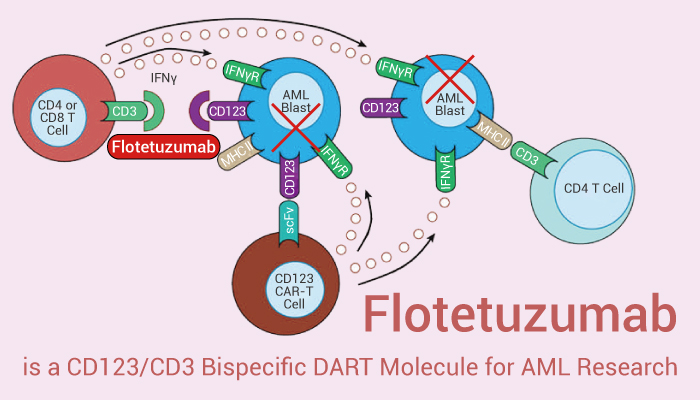Acute myeloid leukemia (AML) is a disease along with poor prognosis. AML results from rapid proliferation of immature myeloid cells in the bone marrow. CD123 (IL3RA) is expressed in the cell-surface of nearly all AML samples (such as AML blasts and leukemia stem cells). In addition, the expression of CD123 also increases in poor-prognosis tumors. Therefore, CD123 is a high-priority target for AML research. Flotetuzumab (MGD006), a CD123/CD3 bispecific dual-affinity retargeting antibody (DART) molecule, can simultaneously bind CD123 on AML cells and CD3 on the effector T cells. Thence, Flotetuzumab is able to activate T cell and leads to T-cell-mediated cytotoxicity in AML blasts.

Flotetuzumab is a CD123/CD3 bispecific dual-affinity retargeting antibody (DART) molecule, and has anti-AML activity.
In vitro, Flotetuzumab (10-6-102 ng/mL; 24 h) shows cytotoxicity against the Kasumi-3 AML cell line using human or cynomolgus PBMCs. Besides, Flotetuzumab (0.01 and 0.1 ng/mL; 144 h) increases IFN-γ, IL-10, and IL-6 secretion in primary PBMCs. Flotetuzumab (0.01 and 0.1 ng/mL; 6 d) also inhibits leukemic blasts growth. It also induces a concomitant expansion of autologous T cells, up-regulation of the proliferation marker Ki-67, and an expansion of CD8+ cells.
In vivo, Flotetuzumab shows inhibitory effect on a mouse model of acute myeloid leukemia (AML). Specifically, Flotetuzumab (0.5-4 μg/kg; intraperitoneal implantation with mini-osmotic pumps; continuous infusion for 6 d) shows antitumor activity in human PBMCs-reconstituted tumor-bearing mice. In a mouse NTPL-146 PDX model of AML, Flotetuzumab (0.5 mg/kg; once every 5 d; for 30 d) improves mouse survival and induces T-cell proliferation.
In conclusion, Flotetuzumab is a CD123/CD3 Bispecific DART Molecule. Flotetuzumab shows great antitumor activity in AML mouse model. Importantly, Flotetuzumab is being investigated in clinical-stage.
References:
[1] Chichili GR, et al. Sci Transl Med. 2015 May 27;7(289):289ra82.
[2] Barwe SP, et al. J Clin Med. 2022 Feb 28;11(5):1333.
[3] Uy GL, et al. Blood. 2021 Feb 11;137(6):751-762.